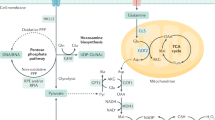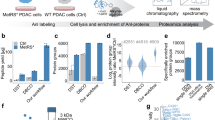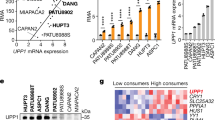Abstract
Mammalian tissues rely on a variety of nutrients to support their physiological functions1. It is known that altered metabolism is involved in the pathogenesis of cancer, but which nutrients support the inappropriate growth of intact malignant tumors is incompletely understood2,3. Amino acids are essential nutrients for many cancer cells4,5 that can be obtained through the scavenging and catabolism of extracellular protein via macropinocytosis6,7. In particular, macropinocytosis can be a nutrient source for pancreatic cancer cells, but it is not fully understood how the tumor environment influences metabolic phenotypes8 and whether macropinocytosis supports the maintenance of amino acid levels within pancreatic tumors. Here we utilize miniaturized plasma exchange to deliver labeled albumin to tissues in live mice, and we demonstrate that breakdown of albumin contributes to the supply of free amino acids in pancreatic tumors. We also deliver albumin directly into tumors using an implantable microdevice, which was adapted and modified from ref. 9. Following implantation, we directly observe protein catabolism and macropinocytosis in situ by pancreatic cancer cells, but not by adjacent, non-cancerous pancreatic tissue. In addition, we find that intratumoral inhibition of macropinocytosis decreases amino acid levels. Taken together, these data suggest that pancreatic cancer cells consume extracellular protein, including albumin, and that this consumption serves as an important source of amino acids for pancreatic cancer cells in vivo.
This is a preview of subscription content, access via your institution
Access options
Subscribe to this journal
Receive 12 print issues and online access
$209.00 per year
only $17.42 per issue
Buy this article
- Purchase on Springer Link
- Instant access to full article PDF
Prices may be subject to local taxes which are calculated during checkout




Similar content being viewed by others
References
Metallo, C.M. & Vander Heiden, M.G. Understanding metabolic regulation and its influence on cell physiology. Mol. Cell 49, 388–398 (2013).
Mayers, J.R. & Vander Heiden, M.G. Famine versus feast: understanding the metabolism of tumors in vivo. Trends Biochem. Sci. 40, 130–140 (2015).
White, E. Exploiting the bad eating habits of Ras-driven cancers. Genes Dev. 27, 2065–2071 (2013).
Locasale, J.W. Serine, glycine and one-carbon units: cancer metabolism in full circle. Nat. Rev. Cancer 13, 572–583 (2013).
Wise, D.R. & Thompson, C.B. Glutamine addiction: a new therapeutic target in cancer. Trends Biochem. Sci. 35, 427–433 (2010).
Kamphorst, J.J. et al. Human pancreatic cancer tumors are nutrient poor and tumor cells actively scavenge extracellular protein. Cancer Res. 75, 544–553 (2015).
Commisso, C. et al. Macropinocytosis of protein is an amino acid supply route in Ras-transformed cells. Nature 497, 633–637 (2013).
Davidson, S.M. et al. Environment impacts the metabolic dependencies of Ras-driven non–small cell lung cancer. Cell Metab. 23, 517–528 (2016).
Jonas, O. et al. An implantable microdevice to perform high-throughput in vivo drug sensitivity testing in tumors. Sci. Transl. Med. 7, 284ra57 (2015).
Schilling, U. et al. Design of compounds having enhanced tumour uptake, using serum albumin as a carrier. Part II. In vivo studies. Int. J. Rad. Appl. Instrum. B 19, 685–695 (1992).
Steinfeld, J.L. I131 albumin degradation in patients with neoplastic diseases. Cancer 13, 974–984 (1960).
Rothschild, M.A., Oratz, M. & Schreiber, S.S. Regulation of albumin metabolism. Annu. Rev. Med. 26, 91–104 (1975).
Gupta, D. & Lis, C.G. Pretreatment serum albumin as a predictor of cancer survival: a systematic review of the epidemiological literature. Nutr. J. 9, 69 (2010).
Andersson, C., Iresjö, B.M. & Lundholm, K. Identification of tissue sites for increased albumin degradation in sarcoma-bearing mice. J. Surg. Res. 50, 156–162 (1991).
Brenner, D.A., Buck, M., Feitelberg, S.P. & Chojkier, M. Tumor necrosis factor-α inhibits albumin gene expression in a murine model of cachexia. J. Clin. Invest. 85, 248–255 (1990).
Fearon, K.C. et al. Albumin synthesis rates are not decreased in hypoalbuminemic cachectic cancer patients with an ongoing acute-phase protein response. Ann. Surg. 227, 249–254 (1998).
Jewell, W.R., Krishnan, E.C. & Schloerb, P.R. Apparent cellular ingress of albumin in Walker 256 tumor and rat muscle. Cancer Res. 35, 405–408 (1975).
Swanson, J.A. & Watts, C. Macropinocytosis. Trends Cell Biol. 5, 424–428 (1995).
Daly, R. & Hearn, M.T.W. Expression of heterologous proteins in Pichia pastoris: a useful experimental tool in protein engineering and production. J. Mol. Recognit. 18, 119–138 (2005).
Tolner, B., Smith, L., Begent, R.H.J. & Chester, K.A. Production of recombinant protein in Pichia pastoris by fermentation. Nat. Protoc. 1, 1006–1021 (2006).
Merlot, A.M., Kalinowski, D.S. & Richardson, D.R. Unraveling the mysteries of serum albumin—more than just a serum protein. Front. Physiol. 5, 299 (2014).
Hou, H.W. et al. Deformability based cell margination—a simple microfluidic design for malaria-infected erythrocyte separation. Lab Chip 10, 2605–2613 (2010).
Hou, H.W. et al. A microfluidics approach towards high-throughput pathogen removal from blood using margination. Biomicrofluidics 6, 024115 (2012).
Mayers, J.R. et al. Elevation of circulating branched-chain amino acids is an early event in human pancreatic adenocarcinoma development. Nat. Med. 20, 1193–1198 (2014).
Racoosin, E.L. & Swanson, J.A. Macropinosome maturation and fusion with tubular lysosomes in macrophages. J. Cell Biol. 121, 1011–1020 (1993).
Klionsky, D.J. Autophagy in mammalian systems, Part B. Preface. Methods Enzymol. 452, xxi–xxii (2009).
Koivusalo, M. et al. Amiloride inhibits macropinocytosis by lowering submembranous pH and preventing Rac1 and Cdc42 signaling. J. Cell Biol. 188, 547–563 (2010).
Commisso, C., Flinn, R.J. & Bar-Sagi, D. Determining the macropinocytic index of cells through a quantitative image-based assay. Nat. Protoc. 9, 182–192 (2014).
Bardeesy, N. et al. Both p16Ink4a and the p19Arf–p53 pathway constrain progression of pancreatic adenocarcinoma in the mouse. Proc. Natl. Acad. Sci. USA 103, 5947–5952 (2006).
Whatcott, C.J. et al. Desmoplasia in primary tumors and metastatic lesions of pancreatic cancer. Clin. Cancer Res. 21, 3561–3568 (2015).
Mahadevan, D. & Von Hoff, D.D. Tumor–stroma interactions in pancreatic ductal adenocarcinoma. Mol. Cancer Ther. 6, 1186–1197 (2007).
Manic, G., Obrist, F., Kroemer, G., Vitale, I. & Galluzzi, L. Chloroquine and hydroxychloroquine for cancer therapy. Molecular & Cell. Oncol. 1, e29911–e29912 (2014).
Palm, W. et al. The utilization of extracellular proteins as nutrients is suppressed by mTORC1. Cell 162, 259–270 (2015).
Andersson, C., Lönnroth, C., Moldawer, L.L., Ternell, M. & Lundholm, K. Increased degradation of albumin in cancer is not due to conformational or chemical modifications in the albumin molecule. J. Surg. Res. 49, 23–29 (1990).
Von Hoff, D.D. et al. Increased survival in pancreatic cancer with nab–paclitaxel plus gemcitabine. N. Engl. J. Med. 369, 1691–1703 (2013).
Wosikowski, K. et al. In vitro and in vivo antitumor activity of methotrexate conjugated to human serum albumin in human cancer cells. Clin. Cancer Res. 9, 1917–1926 (2003).
Cregg, J.M., Cereghino, J.L., Shi, J. & Higgins, D.R. Recombinant protein expression in Pichia pastoris. Mol. Biotechnol. 16, 23–52 (2000).
Wyckoff, J., Gligorijevic, B., Entenberg, D., Segall, J. & Condeelis, J. High-resolution multiphoton imaging of tumors in vivo. Cold Spring Harb. Protoc. 2011, 1167–1184 (2011).
Sahai, E. et al. Simultaneous imaging of GFP, CFP and collagen in tumors in vivo using multiphoton microscopy. BMC Biotechnol. 5, 14 (2005).
Acknowledgements
The authors wish to dedicate this paper to the memory of Katherine Kellersberger. We thank the MIT Department of Chemical Engineering and J. Francois-Hamel for access to bioreactor equipment, R. Bronson for pathological grading of tumors and A. Lau for providing tumor-bearing mice. S.M.D. and A.L. received support from a National Science Foundation Graduate Research Award Fellowship, and support from T32 GM007287 is also acknowledged. O.J. received support from the Koch Institute Frontier Grant and the Prostate Cancer Foundation. J.R.M. acknowledges support from grant F30CA183474 from the NCI and grant T32 GM007753 from NIGMS. M.A.K. and G.S. acknowledge support from NIH grants 1R01 DK075850-01 and 1R01 CA160458-01A1. M.G.V.H. acknowledges support from the Lustgarten Foundation, the Ludwig Center at MIT, the Broad Institute SPARC program, the Burroughs Wellcome Fund, SU2C and the NIH (P30 CA1405141, R01 CA168653). H.W.H. and J.H. acknowledge support by DARPA's Dialysis-Like Therapy (DLT) program under SSC Pacific grant N66001-11-1-4182. This work is also supported by the use of MIT's Microsystems Technology Laboratories.
Author information
Authors and Affiliations
Contributions
Conceptualization: S.M.D., O.J. and M.G.V.H. Methodology: S.M.D., O.J., M.A.K., H.W.H., A.L., J.R.M., J.W., A.M.D., M.W., C.R.C., K.J.C., A.L., K.A.K., B.K.S., G.S., J.H. and D.B.-S. Formal analysis: S.M.D., O.J. and A.M.D. Investigation: S.M.D. and O.J. Writing original draft: S.M.D., O.J. and M.G.V.H. Visualization: S.M.D., O.J. and M.G.V.H. Supervision: M.J.C., R.L. and M.G.V.H. Funding acquisition: O.J., J.D.R., R.L. and M.G.V.H.
Corresponding author
Ethics declarations
Competing interests
The authors declare no competing financial interests.
Supplementary information
Supplementary Figures
Supplementary Figures 1–4 (PDF 452 kb)
Rights and permissions
About this article
Cite this article
Davidson, S., Jonas, O., Keibler, M. et al. Direct evidence for cancer-cell-autonomous extracellular protein catabolism in pancreatic tumors. Nat Med 23, 235–241 (2017). https://doi.org/10.1038/nm.4256
Received:
Accepted:
Published:
Issue Date:
DOI: https://doi.org/10.1038/nm.4256
This article is cited by
-
Progesterone receptor potentiates macropinocytosis through CDC42 in pancreatic ductal adenocarcinoma
Oncogenesis (2024)
-
Metabolic heterogeneity in cancer
Nature Metabolism (2024)
-
Amino acid intake strategies define pluripotent cell states
Nature Metabolism (2024)
-
Single protein encapsulated SN38 for tumor-targeting treatment
Journal of Translational Medicine (2023)
-
Gemcitabine promotes autophagy and lysosomal function through ERK- and TFEB-dependent mechanisms
Cell Death Discovery (2023)



